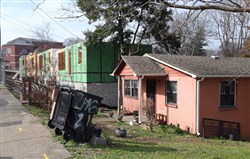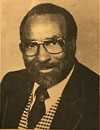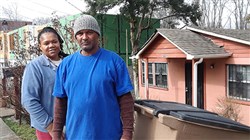VOL. 44 | NO. 6 | Friday, February 7, 2020
Garden memories yield to tall-skinnies

Gordon Memorial United Methodist church, left, and the home of Tammy Pride and Michael Cheatham, right, bookend a construction project that covers Dogan’s Garden and other parts of the Herman Street neighborhood.
-- Photo By Tim Ghianni | The LedgerDogan’s Garden – where I discovered mental, physical and spiritual respite – is gone, all but its memory erased by development and viral heritage neglect.

Williams
When I learned the home with its yard filled with countless multicolored plastic tulips had been sacrificed, I hastily drove to 2122 Herman Street, where the Rev. Dr. Dogan W. Williams – “just call me Dogan” – had retired after a career in the United Methodist ministry and a life spent advocating equality, kindness, scriptures, Jesus and easy friendship’s warm embrace.
That garden first drew me to this address. More on that later, because it was the man who kept me coming back … until he died Jan. 23, 2010. He was 96 years old and, though his body displayed the strains of age that made difficult the “little things,” like seeing clearly and moving quickly, his warmth and wisdom never vanished until he did. And I’ll just bet he was wearing proudly his NAACP medallion when that time came.
Dogan’s Garden – as “The Herman Street Kids” (as the neighborhood children called themselves) and their folks had referred to it – was a fetching assortment of flags, artificial flowers, signs and decorative paraphernalia, and it couldn’t help but raise a smile to those who drove past. The tulips and flags faded, but the garden remained for years in front of his empty home after his death.
Those worn-out decorations disappeared for the most part a few years ago when the home became a rental property, where – neighbors say – “three white boys, college students” lived.
“They were nice. They always spoke,” says Tammy Pride, who, with her boyfriend of more than 3½ decades, is renovating a similar house at 2116 Herman.
Dogan’s old house was a single story in front with a walkout in back, which was where people entered offices in which he offered family counseling and God-loving consultation.
Tammy’s house is of the same basic vintage and style (without the walkout). The big difference on this gloomy North Nashville day is that Dogan’s house is gone, scraped off the ground along with a couple more to make room for a herd of tall-skinnies, the architecture homogenizing our city.
Tammy’s house not only stands, but it is being restored to the glory it surely had when her family first moved to Herman Street 70-plus years ago.
“It was my great-grandmother’s house and my grandmother’s house,” she tells me as she stands on her front porch, her voice rising slightly above the squad of hammers that are connecting the 2-by-4s that workmen push above the first floors of the new houses that jut into the sky above the neighborhood’s formerly low-slung skyline.
These guys just are doing their jobs, of course. Can’t fault them for not knowing they are working on top of the once-heart lifting field of plastic tulips and the like that greeted visitors to Dogan’s clock-filled home.
Clocks ticking to precision were his passion, and I’ll mention them again later. The time they chronicled, of course, was his eventual enemy. It’ll get all of us someday, they tell me, though I’ll believe it when I can’t see it anymore.

Bowen
William “Bill” Bowen, 71, a retired teacher who uses his precise and commanding voice in his attempt to inspire and direct young and old to their GED certificates at the Davidson County jail, long ago was a parishioner of the Rev. Dogan when he was pastor at Gordon Memorial UMC, just up the street from Dogan’s Garden.
The two remained friends for life, and Bill regrets he no longer can visit the house fronted by the garden.
He also says 10 houses are going to be squeezed atop land that had held three classic North Nashville cottages, minding their own business, for decades. Dogan’s Garden, of course, was in front of one of them.
The new homes likely will be identical to those that have sprung up on Batavia, just up the hill, over on Clifton, and all the way down Herman to the Pearl-Cohn football field, where doubtless the neighborhood-minded Dogan went to see the Firebirds play or before that visited the segregated black schools that once stood there.
Where houses haven’t yet been leveled, dumpsters – metal bins filled with stained drywall, shattered beams, derelict furniture and memories – are “parked” along roadways and nudged into temporarily empty lots.
“I don’t like it,” says Tammy, watching this activity in the neighborhood where she is restoring the house where her grandmother and great-grandmother lived since 1948.
“It’s the only house my grandmother ever knew,” she adds, referring to Naomi Larkins, who died March 30 at age 91. She lived elsewhere prior, but this house was where Naomi spent most of her years and where she helped raise generations of her family’s children.

Christman
“Grandma was the oldest person on the street,” says to Tammy’s cousin, Derrica Christman, 47, the family historian with whom I speak after a phone introduction by Tammy.
“She (Naomi) came with her mother, Cornelia Wallace,” to Herman Street, first staying in a brick house “up past Gordon (Memorial United Methodist) Church” before settling in together at 2116, Derrica says.
“It was a duplex until the house burned in 1960,” Derrica points out. “They stayed over on the next street with a friend until the house was rebuilt in 1961.”
Restoring and living in the home is Tammy’s mission of love and legacy.
“We decided it had to stay in the family,” she explains, adding that much of her youth was spent here with her granny and great-granny.
Another branch of Derrica’s kinfolk also lived nearby: Her great-grandfather from the other side of her family, George Hill, lived across the street from Dogan.
And then there was Dogan, the preacher and civil rights activist who spent 15 years up the street in the Gordon Memorial UMC pulpit before his Methodist circuit-riding took him elsewhere. But he didn’t permanently leave the neighborhood, even as he moved around the South and stood in pulpits in Murfreesboro, Bristol and elsewhere.
He had purchased the house at 2122 Herman Street to be his retirement roost, allowing his grown children and their families to occupy it until he returned.
“When I was a child, Dogan was my pastor at Gordon,” Derrica continues. “He lived in the parsonage, a house that used to be beside the church (which will be celebrating its 145th anniversary in 2021, after making history recently by hiring the Rev. Dr. Paula B. Smith as the first female pastor in the church’s 14-plus decades offering services and salvation.)

Tammy Pride and her long-time partner Michael Cheatham are working on the family home where Tammy spent much of her youth visiting her grandmother and great-grandmother.
-- Photo By Tim Ghianni | The LedgerDerrica says Dogan finally retired in the early 1990s and moved back to North Nashville and into the house where he planted his roots and plastic tulips.
He was the heart of this close-knit and loving neighborhood that is on the verge of obliteration unless others, like Derrica’s cousin Tammy, decide to save their family homes.
“Dogan was like family, really. We were all like family,” says Derrica, adding that Dogan’s granddaughter, Frankie Williams Kimbro, remains her best friend.
“Dogan was all about community. He was very invested in children,” notes Derrica, who moved in with her grandmother and great-grandmother after her 1972 birth.
“I was raised by my grandma,” she says. “And I raised my four oldest children in that house.
“Dogan and my grandma kind of looked out for each other because they were the oldest people in that block.”
A man of the cloth and of peace, he also was the neighborhood grandpa if one was needed.
“When my son was 12, he’s 26 now, Dogan gave my son an award for being a straight-A middle-school student. He gave him a clock, because clocks were his thing. I still have the clock.”
The children, their children and their children’s children – “my grandmother always was raising kids,” Derrica says – all looked out for Dogan.
“My grandma raised us to know that you take care of your neighbors like we take care of family.
“My grandma took care of my great-grandma until she died at home. My grandmother took care of my great-grandfather (across the street from Dogan) until the time he died in 1998 at home.”
And that family compassion was extended to the brilliant and kind old gentleman who was a friend of Martin Luther King Jr. (Dogan was among a group of local pastors who were in Memphis to listen to Martin’s “I’ve Been to the Mountaintop” speech the night before he was murdered.)
Dogan also brought black activist Angela Davis, the left-wing ideologist, to speak at Gordon Memorial back when he was pastor. He told me a couple of decades ago that some people didn’t quite understand it, but he thought it was necessary.
“Dogan did things that you wouldn’t imagine,” recalls his pal, the church historian Bill Bowen, talking about the soft-spoken civil rights leader.
“He was a gentleman,” says Bill, adding that in his sermons, Dogan delivered messages that led congregants to think and search. He was not a hellfire guy who told them what to think and who to fear.
And as for civil rights, well “he was hard on his campaign,” Bill says. “He was a one-of-a-kind, kind of man. Every time you’d see him, he’d have on those dress trousers, with suspenders and the button-up shirt and tie.”
I remind Bill that Dogan always wore his NAACP medallion proudly dangling from his neck, hanging dead center over his heart and necktie.
Trusting of his fellow man, this sharp-dressed man of the cloth would simply holler “c’mon in, it’s unlocked” to me, morning or evening, if I knocked on his front door, sometimes bringing him his favorite chicken breast from Sweat’s, the neighborhood headquarters and purveyors of what we used to call “soul food,” when I was growing up in Chicago. I told him he should keep his door locked, and he just shrugged.
“When he was sick, we used to go check in on him and help him out,” says Tammy, nodding from her house at 2116 up to the crew of busy workmen quickly assembling the 2-by-4s above Dogan’s Garden and adjoining lots.
“We all still talk about Dogan’s Garden,” Derrica adds. “He’d decorate his house and yard out for different occasions” like Christmas, Thanksgiving, Valentine’s Day and The Fourth of July, “but the flags were there all the time.”
The Herman Street Kids helped the old preacher keep up his “garden” and porch in his later years. “Once Dogan got to the point where he wasn’t moving around or anything, my grandma took care of him,” Derrica recalls.
“We, the children of the neighborhood, there wasn’t too many of us, my brother and I and my older children, we would go help him.
“He couldn’t get out and do it anymore. He’d get the kids to come up, and we’d do that decorating and stuff.”
I’m in this neighborhood today because I’d heard that Dogan’s house (and garden) were gone and timbers of progress were rising instead into the cool winter sky.
It was important to me because I’d first discovered Dogan’s Garden around the turn of the century. I was driving through streets of North Nashville, looking for someone or something to write a column about, when I saw the flags blowing in the wind, presiding over tulips blooming into the dead of winter.
I stopped and knocked on the door of the house, but no one was home. I drove past many times until one day I saw this elderly gentleman, dressed in dark trousers and a shirt and tie, on the front porch. I got out of the car and asked him – from the street – “How are you doing today, sir?” or some such.
He waved for me to come sit by him and talk, which we did for a couple of hours.
“It was my great pleasure to introduce Martin (MLK) on a couple of occasions,” he told me, when I finally got around to writing a column about him in the summer of 2004. “Real nice fella. Everybody wanted to hear Martin.” That great American even had been Dogan’s houseguest.
Then 81, Dogan gave me a tour of his field of plastic tulips punctuated by the flags, signs and, If I remember correctly, a whirligig or two.
“I’ve had people tell me I need to call the newspaper about my garden,” he said, after I sat next to him. “Glad to see you.” (I was working for The Tennessean, Nashville’s morning newspaper, at the time.)
On that first visit, he led me beneath the “God Bless All Who Enter Here” sign and into the living room of his house. “The Price is Right” – his favorite TV show – was blaring from the television, Bob Barker and a game of Plinko or Punch-a-Bunch almost drowning out the chiming and tick-tocking of his 170 clocks.
He told me he bought the house in 1967 as a simple investment. He hadn’t necessarily planned on retiring here, although I’m sure it was destiny.
“I wanted to have a voice,” he said. “The only way you can have a voice is if you own property. I’ve been owning property ever since I was 12 and my daddy let me buy 10 acres of land and sold me four heifer calves.”
Over the years there were many conversations. He was a great preacher, sure. He also was one helluva guy.
“Nobody was really a stranger to Dogan,” says Bill, the historian. “He was a very welcoming guy. He’d tell young people ‘YOU CAN DO THAT’” when he was encouraging them toward schooling, scriptures and success.
“He was a big, big, big, big encourager,” adds Bill, recalling his first confidence-building encounter. “I was a senior in high school at Pearl High. He was real proud that I had enrolled at Fisk.
“After I graduated and went on to Fisk, Dogan – who would have Youth Day at church – made me one of the speakers. That was one of my first speaking engagements.”
Out on Herman Street, while I’m taking a few pictures of the construction forever erasing the spot where my old friend gave me needed refuge, the Rev. Dr. Yvette M. Tisdale stops to ask me if I’m a developer.
Seems they have a parcel near her church, St. Luke AME on 40th, for which they are seeking $80,000. A white guy with a ponytail standing out in the middle of Herman Street and taking pictures of “urban renewal” can easily be mistaken for a developer she says, by way of unnecessary apology.
I tell her why I’m there and show her where I had been pointing the camera.
“I knew Dogan Williams,” she says. “He was real enjoyable. He was strongly into civil rights. With the NAACP he fought for black people’s rights.
“He was always politically active. He just stood up strongly against injustices.”
Then she laughs. “On every spot, every wall in his house, he had a clock. Big ones. Little ones. Unique ones. Crazy ones. Big, valuable clocks.
“He would always tell me that time waits for no man.”
Dogan told me long ago that he started collecting clocks after an amicable divorce from a wife who didn’t like clocks. Time really mattered until it ran out.
“He had gotten sick and had to go to the hospital, and they decided he wasn’t well enough to go home, and they had to put him in a nursing home,” Derrica remembers.
“Everybody knew he wasn’t going to be too much longer after that,” she says. “We were raised to believe that once an elder is removed from their home, their chance of living much longer after that was short, because home is all we know. We in the neighborhood knew he wasn’t going to live much longer.”
Death cut way short the nursing home stay. Since he couldn’t return to his home on Earth, Dogan went to the eternal home he’d been detailing for decades.
Dogan’s Garden was more than a landmark for The Herman Street Kids as they roamed freely, “as long as we stayed between the railroad tracks and Gordon Church,” Derrica says.
“He thought the garden was a cheerful thing to do. He wanted people to see it and pass by and have it brighten their days. Brighten his day. He enjoyed seeing other people happy.”
Even though she lives elsewhere now, in West Nashville, most of her friends are former Herman Street Kids, though few of them live here now. Fewer still will live here in the future, as more earth is scraped and 2-by-4s sprout.
“The neighborhood has changed,” Derrica acknowledges. “It ticks me off, because I remember what it looked like growing up. I remember Herman Street being filled with houses, and people in those houses.
“To think that all those houses are being torn down and replaced with this junk really upsets me. They are more concerned with profits and dollar signs now than they are in helping the community stay strong.
“Nothing that they are building now is for people from that neighborhood. They are buying low and selling high,” she says, of the trend not just in this neighborhood, but across Nashville.
“I’ve heard of instances where they are basically forcing people out by different tactics and offering them amounts that would seem high to them, but they (the developers) know clear well that it’s not near enough for somebody to go someplace else in town.
“And landlords see dollar signs and they say ‘Hey, I’m going to sell,’ not considering their tenants and knowing those tenants don’t have a place to go.”
Derrica says it is “disheartening,” but she’s proud her cousin Tammy and her partner Michael Cheatham are breathing life into the house where she grew up.
Michael, 54, stands on the porch of 2116 Herman Street and drags slowly on a cigarette and watches the houses being built, basically on top of each other, a few feet from his house.
“Once we get the bathroom in on the weekend, we’ll be able to live here,” he says. “I can live here and tinker with it until 12 at night if I want to.’’
In recent weeks, he’s been cleaning up and removing parts of floors and walls, doing whatever is necessary to get the home ready for patching, painting and new fixtures.
While he lives in Hopkinsville (sort of) and Tammy lives in Hermitage, he’s looking forward to living full time in this house on Herman Street.
“We got a son. He’s grown and in Florida. He’s 36,” he says.
“It’s been off and on” for this couple a long time. More on than off, and they both look forward to moving in here when the house is habitable, they hope by the end of this month.
Michael, who has spent his life on construction sites, looks at the houses rising on the street where he expects to spend the rest of his life. He and Tammy are preserving history, but he also recognizes opportunity among the 2-by-4s and concrete.
“Seeing that work means the economy is booming and there are jobs,” he says. “I notice a lot of Mexicans, but that’s all right. I think that if you have the experience and can do the job, you probably can walk on and get hired” as Nashville booms … and old neighborhoods like this one are erased.
“I drive a forklift. I can drive all kind of equipment,” he says, adding that while Hopkinsville is officially home, he’s spent most recent decades in Nashville with Tammy. “She can’t get rid of me,” he continues, leading me inside to show off the life he’s installing inside the house’s worn shell.
“This was her grandmother’s house. The only house she ever lived in.
“The kitchen I got to do,” he says, as he leads me past the paint cans and a black-metal Louisville Slugger – protection perhaps? – to the room where he and Tammy will prepare their meals.
“There is a little work to do. Ain’t bad,” he says, turning into one of the bedrooms.
“You think I can get one of the construction foremen to take my scrap when they get theirs?” he asks rhetorically, pointing through a window to a pile of old drywall, timbers and other scraps he’s assembled near the alley that passes by the backyard. “In this neighborhood, people come through there at night and they pick through the scrap. I found syringes out there.”
Michael points to the ceiling, noting a brownish spot where the roof has leaked. After repairing the leak, he’s now trying to figure out how to patch the ceiling well enough that it will blend in with the popcorn texture. He’s pretty sure he can do that, he says.
Tammy, also 54, says she’s proud to be saving this house for herself and for future generations.
As for the new construction next door and all the way past the former site of Dogan’s Garden?
“I don’t like it,” she says. “The houses are too close. If they catch on fire, this one is going to catch on fire, too.
“They are putting them (new houses) up everywhere. It’s like they are just throwing them up.”
She says that for now she lives in one of the “It City’s” new apartment complexes, “where the walls are so thin, you can be upstairs and hear the whole conversation of the people downstairs. No insulation.”
Those shortcuts weren’t made when this house was built, which is why she expects to live here for life, just as did her grandmother and great-grandmother.
Oh yeah, it doesn’t bother her that most of the newcomers are white. “Color? I don’t see no color.”
Still she’s furious that more people aren’t doing what she and Michael are doing, breathing life into family homes before they become reprobate fodder for bulldozers and scrapers.
“If the houses are there, they should leave them and fix them up instead of tearing them down and building those skinny houses. And they run all the old people out.”
I walk up Herman Street to watch the workers put up more framing on the house being built where Dogan told me about his friend Martin while we watched flags flutter over the field of multicolored plastic tulips. I wish I could get back to the garden.